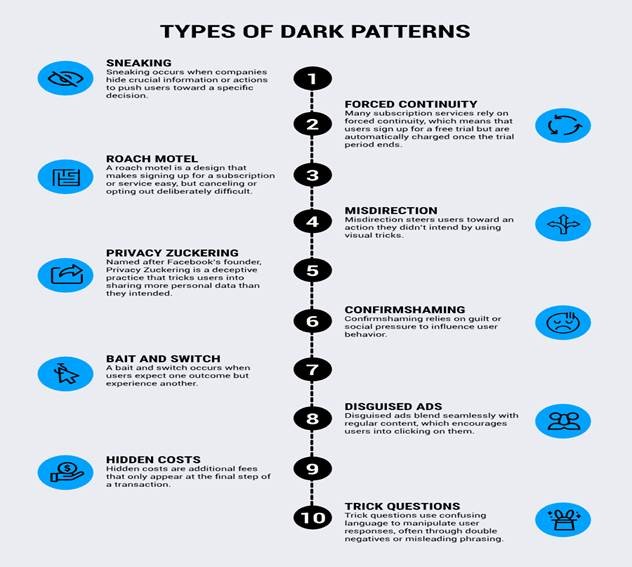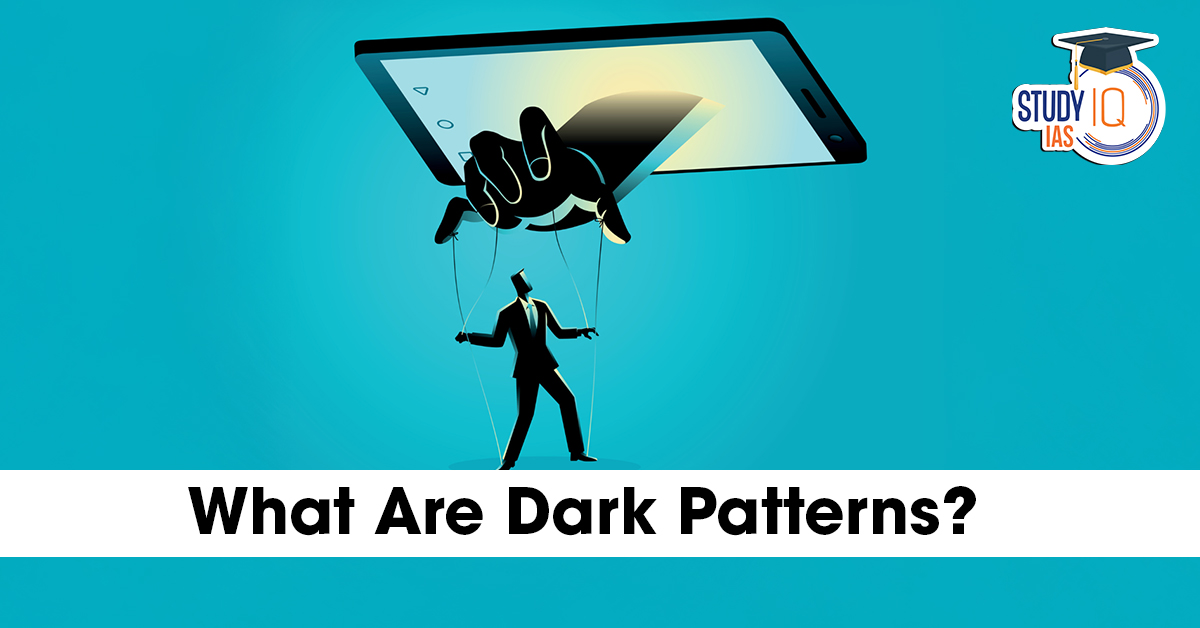Table of Contents
Context: The Central Consumer Protection Authority (CCPA) issued notices to 11 companies for using dark patterns, violating its 2023 guidelines.
What Are Dark Patterns?
A dark pattern is a user interface that has been crafted to trick or manipulate users into making choices that are detrimental to their interests. Dark patterns encompass various manipulative practices such as drip pricing, disguised advertising, bait and click, choice manipulation, false urgency, and privacy concerns.
- Origin of Term: Coined in 2010 by UK-based user experience designer Harry Brignull.
- Definition: User interfaces deliberately designed to mislead or manipulate users into taking actions they may not have intended.
- Sectors Affected: Common across e-commerce, travel, health, retail, and social media platforms.
- Common Examples:
- Sneak into Basket: Adding items to a cart without the user’s consent.
- Deceptive Button Design: Highlighting “Accept” (e.g., for cookies) while hiding or minimising the “Reject” option.
- Hidden Costs: Revealing extra charges only at the final checkout stage.
- Intent: Crafted to benefit companies by nudging users into disadvantageous decisions.
- Legal Status: Often operates in a legal grey area, exploiting loopholes in consumer protection laws.
In India
- Issued By: Central Consumer Protection Authority (CCPA)
- Legal Basis: Consumer Protection Act, 2019
- Guidelines Name: Guidelines for Prevention and Regulation of Dark Patterns, 2023
- Date of Notification: 30 November 2023
- Applicable To: Advertisers, sellers, and platforms offering goods/services in India (including e-commerce and digital platforms)
Types of Dark Patterns
- Urgency: This tactic creates a sense of urgency or scarcity to pressure consumers into making a purchase or taking an action.
- Basket Sneaking: Websites or apps use dark patterns to add additional products or services to the shopping cart without user consent.
- Confirm Shaming: It involves guilt as a way to make consumers adhere. It criticises or attacks consumers for not conforming to a particular belief or viewpoint.
- Forced Action: This involves forcing consumers into taking an action they may not want to take, such as signing up for a service to access content.
- Nagging: It refers to persistent, repetitive and annoyingly constant criticism, complaints, and requests for action.
- Subscription Traps: This tactic makes it easy for consumers to sign up for a service but difficult for them to cancel it, often by hiding the cancellation option or requiring multiple steps.
- Interface Interference: This tactic involves making it difficult for consumers to take certain actions, such as cancelling a subscription or deleting an account.
- Bait and Switch: This involves advertising one product or service but delivering another, often of lower quality.
- Hidden Costs: This tactic involves hiding additional costs from consumers until they are already committed to making a purchase.
- Disguised Ads: Disguised ads are advertisements that are designed to look like other types of content, such as news articles or user-generated content.

Why Are Dark Patterns Hard to Regulate?
- Lack of Specific Law: Most countries, including India, do not have a dedicated law explicitly banning dark patterns.
- Broad Legal Coverage: In India, the Consumer Protection Act, 2019 prohibits unfair trade practices, but dark patterns are not always clearly defined under it.
- Global Examples of Action:
- In 2022, Google and Facebook were fined in the EU and France for making it easier to accept cookies than to reject them — a typical dark pattern tactic.
Working of Dark Patterns
These deceptive practices prompt the users to buy a particular product or a service even when they do not give their exclusive consent. Some examples are:
- Tech Firms: Social media companies and Big Tech firms such as Apple, Amazon, Skype, Facebook, LinkedIn, Microsoft, and Google use dark or deceptive patterns to downgrade the user experience to their advantage.
- Amazon: Amazon came under fire in the EU for its confusing, multi-step cancellation process for the Amazon Prime subscription.
- After communicating with consumer regulators, Amazon made its cancellation process easier for online customers in European countries.
- LinkedIn: In social media, LinkedIn users often receive unsolicited, sponsored messages from influencers.
- Disabling this option is a difficult process with multiple steps that requires users to be familiar with the platform controls.
- Instagram: As Meta-owned Instagram pivots to video-based content to compete against TikTok, users have complained that they are being shown suggested posts they did not wish to see and that they are unable to permanently set preferences.
- YouTube: Google-owned YouTube nudges users to sign up for YouTube Premium with pop-ups, obscuring the final seconds of a video with thumbnails of other videos, a way of disrupting what should have been an otherwise smooth user experience.
Dark Pattern Tactics
- Baseless countdowns for online deals
- Terms and conditions in fine print that add on to costs
- Making cancellation buttons hard to see or click
- Making sponsored ads appear as news reports or celebrity endorsements
- Auto-playing videos on sites
- Forcing users to create accounts to finish a particular transaction
- Silently charging credit cards after the end of a free trial
- Using dull colours to hide information that users should be aware of
Problems with Dark Patterns
Dark patterns confuse users, introduce online obstacles, make simple tasks time-consuming, have users sign up for unwanted services/products, and force them to pay more money or share more personal information than they intended.
- By using dark patterns, digital platforms take away a user’s right to full information about the services they are using and reduce their control over their browsing experience.
- Dark patterns endanger the experience of Internet users and make them more vulnerable to financial and data exploitation by Big Tech firms.
- Dark Patterns are designed to subvert or impair user autonomy, decision-making or choice.
- Dark Patterns can lead to unintended purchases, addiction and overuse and privacy violations.
- Deceptive patterns in online advertising mislead consumers, ruin their online experience, and erode trust in brands and advertising.
- Subscription traps, the tactic that makes it easy for consumers to sign up for a service but difficult for them to cancel it, and hiding additional costs, particularly by travel and tourism websites.
- The increasing prevalence of these deceptive practices that infringe on consumer rights.
- As per a report by the US Federal Trade Commission, as augmented reality (AR) and virtual reality (VR) platforms and devices grow in usage, dark patterns will likely follow users to these new channels as well.
Use of Dark Patterns
- Big Techs such as Apple, Amazon, Skype, Facebook, LinkedIn, Microsoft, and Google have been using dark patterns to downgrade the user experience to their advantage.
- Example 1: Amazon has attracted criticism in the EU for its confusing, multi-step cancellation process for the Amazon Prime subscription.
- Later, it was forced to make its cancellation process easier for online customers in European countries.
- Example 2: LinkedIn users often receive unwanted, sponsored messages from influencers. Disabling this option is a complex process that requires users to be familiar with the platform controls.
- Example 3: In order to popularise their video creation platform, Instagram was showing users posts they did not wish to see, and they were unable to permanently set preferences.
- Sponsored video ads are being sandwiched between reels and stories that users originally opted to view.
- Example 4: YouTube nudges users to opt for YouTube Premium with pop-ups, obscuring the final seconds of a video with thumbnails of other videos.
- Example 5: Amazon launching a supposedly ‘free’ children’s app that fooled its young users into making in-app purchases that their parents had to pay for.
Impact of Dark Patterns on Users
- Exploitation: Dark Patterns endanger the user experience and make them more vulnerable to financial and data exploitation by Big Tech firms.
- Time-consuming: Dark Patterns confuse users by introducing online obstacles that make simple tasks time-consuming.
- Other impacts: Dark Patterns make users sign up for unwanted services, and force them to pay more money or share additional personal information than they intended.
Global Laws Against Dark Patterns
Several governments across the globe have defined ‘dark patterns’ and brought in strict laws against them.
- US: In the U.S., the Federal Trade Commission [FTC] has taken note of dark patterns and the risks they pose. In a report released in September 2022 year, the regulatory body listed over 30 dark patterns, many of which are considered standard practice across social media platforms and e-commerce sites.
- FTC report outlined its legal action against Amazon in 2014, for a supposedly “free” children’s app that fooled its young users into making in-app purchases that their parents had to pay for.
- EU: The European Union has enacted the Digital Services Act (DSA) to curb the menace of dark patterns and create a safer digital space in which the fundamental rights of all users of digital services are protected.
- DSA regulates digital services that act as “intermediaries” in their role of connecting consumers with content, goods and services.
- This means not only are the likes of Facebook and Google within the scope of the bill, but also Amazon and app stores.
- Violations carry the threat of a fine of 6% of global turnover and, in the most serious cases, a temporary suspension of the service.
Need to Regulate Dark Patterns in India
Digital space has become an integral part of the consumer’s life, significantly influencing how they consume information, goods and services.
- Certain aspects of UI/UX design and online choice architecture guide consumer choices. However, when manipulated to the detriment of consumers, they become a cause of concern.
- Online space in India has experienced an impressive growth in recent years, with the number of internet connections reaching 830 million in 2021.
- Moreover, India’s consumer digital economy is anticipated to hit the US$1 trillion mark by 2030, growing from US$537.5 billion in 2020.
- This is attributed to the strong adoption of online services like e-commerce and edtech in the country.
- With the growing penetration of the internet and rising smartphone usage in India, consumers are increasingly choosing e-commerce as the preferred mode of shopping.
- In such a scenario, it is essential that online platforms do not indulge in unfair trade practices by incorporating dark patterns which result in a harmful or undesirable outcome for the consumer.
Regulatory Framework in India
- Consumer Protection Act 2019:
- Deceptive patterns that manipulate consumer choice and impede their right to be well informed constitute unfair practices that are prohibited under the Consumer Protection Act 2019.
- Department of Consumer Affairs (DoCA):
- It is one of the two Departments under the Ministry of Consumer Affairs, Food & Public Distribution. Implementation of the Consumer Protection Act, 2019.
- Advertising Standards Council of India (ASCI):
- It is an independent, voluntary self-regulatory organisation formed in 1985 by professionals from the advertising and media industry to keep Indian ads decent.
- It aims to ensure advertisements in India are fair, honest and are compliant with the ASCI Code.
Way Forward for India
- Guidelines by the Centre: The Department of Consumer Affairs will frame specific guidelines with the Advertising Standards Council of India to curb the menace of dark patterns.
- Industry Self-Regulation: The Government has asked e-commerce firms like Flipkart, Zomato, Amazon, Meta, and Google to create a self-regulatory framework to stop these practices.
- Online platforms can establish ethical design guidelines that discourage the use of dark patterns.
- Encouraging responsible design practices and conducting independent audits can help identify and rectify dark pattern issues.
- The self-regulatory measures may also include prohibiting specific kinds of dark patterns, fostering consumer-friendly digital choice architecture and empowering regulators.
- Equipping Users: Equipping users with tools and resources that allow them to make informed choices online is another potential solution.
- This could include browser extensions, apps or plugins that detect and block dark patterns or platforms providing clearer and more accessible settings and privacy options.
- Reporting of Cases: Users should be encouraged to report instances of dark patterns they encounter, and platforms should establish clear channels for users to provide feedback and report manipulative practices.
- The Union Consumer Affairs Ministry has also urged consumers to flag such manipulative online practices on the National Consumer Helpline by calling ‘1915’ or through a WhatsApp message to 8800001915.
- MSME Merchants: In addition to promoting awareness about dark patterns among consumers, small and medium-scale MSME merchants must also be made aware, as they account for a huge portion of online sellers.


 Advanced Air Defence Radars: Types, Comp...
Advanced Air Defence Radars: Types, Comp...
 Ion Chromatography, Working and Applicat...
Ion Chromatography, Working and Applicat...
 Broadly Neutralising Antibodies (bNAbs):...
Broadly Neutralising Antibodies (bNAbs):...

























